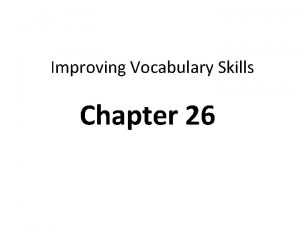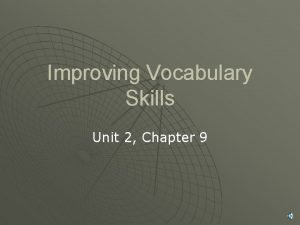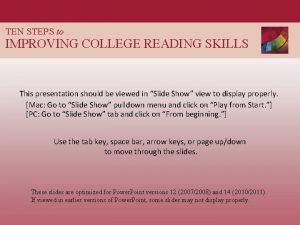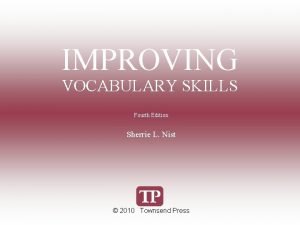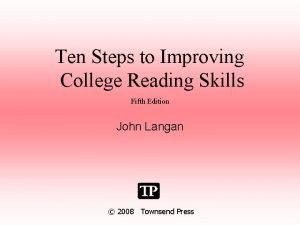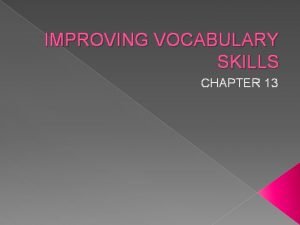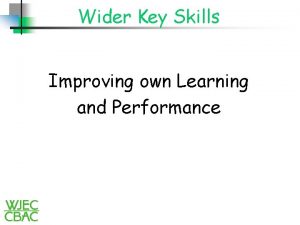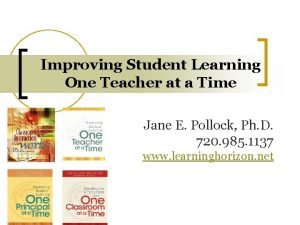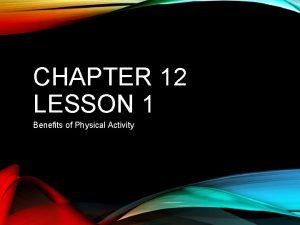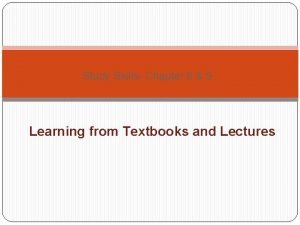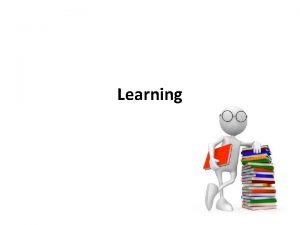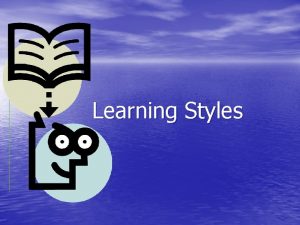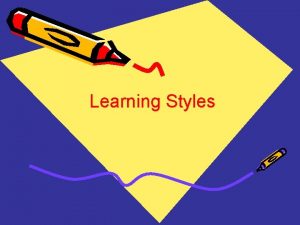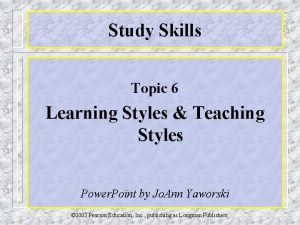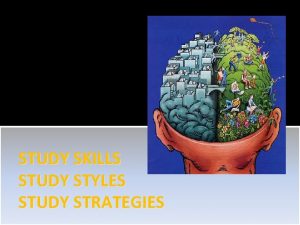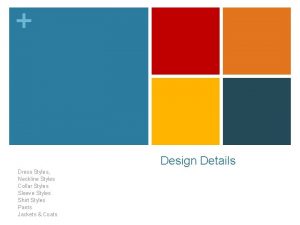Improving Study Skills Chapter 4 Learning Styles Visual












- Slides: 12

Improving Study Skills Chapter 4

Learning Styles • Visual learners are most comfortable getting information from print and images. • Auditory learners prefer lectures, class discussions, and recordings. • Kinesthetic learners like to involve the whole body: role playing, building things. • Tactile learners primarily use their hands: note taking, sketching, diagramming.

Howard Gardner’s Theory of Multiple Intelligences – Theory of intelligence emphasizing that we all have multiple intelligences that operate relatively independently of one another; theory includes eight intelligences. © 2014, 2010, 2007 by Pearson Education, Inc. All rights reserved.


Preparing to Study • Set up a regular study area -comfortable - without visual distractions -free of bothersome noise. • Ask people not to interrupt you. • Schedule regular study time. Try to study every day. • Set study goals.

The PQR Reading System • Preview: Scan the material first. Look for the main points and how it is organized. • Question: Read actively. Ask who, what, where, when, why, and how as you read. • Review: Go back over what you just read. As you see the material, say the main points out loud and write brief notes that outline the main ideas.

Taking Notes • Two-column format: page 98 – Put recall words in the narrow column. – Put main ideas and important facts in the wide column. • Outline format: – Helps you organize facts and ideas as you write them down. – Indentations show relationships between main ideas and supporting details.


Test-Taking Techniques • Skim the whole test before you begin. • Pace yourself. Spend less time on questions that don’t count as much. • Answer the easy questions first. • Make sure you understand each question. • Look for clues to the answer in the question itself.

Read! Read! Read anything and everything! Build your vocabulary Underline words you don’t understand

Before a Test • Study for the test – Review material daily – notes/handouts/book – Categorize topics • Prepare for the test – – Get a good night sleep Have a good breakfast – gains and fruits Check you emotional state – be relaxed Have all your materials ready before you walk in – scantron, essay book, #2 pencils

In Class Activity 5 points • Take the Multiple Intelligence Test • Take out a sheet of paper and answer the following questions. 1. Was the test accurate at assessing your strongest and least strongest type of intelligence? 2. A. What type of intelligences are you strongest in? B. What type of intelligence do you need improvement in? 3. What are some activities you can do to improve your least trongest intelligence? • Turn in your multiple intelligence test and answers to the 3 questions at the end of class. • Don’t Forget to put your name on your papers and staple your papers
 Improving vocabulary skills chapter 26
Improving vocabulary skills chapter 26 Improving vocabulary skills chapter 9
Improving vocabulary skills chapter 9 Ten steps to improving college reading
Ten steps to improving college reading Chapter 2 sentence check 2 answers curt
Chapter 2 sentence check 2 answers curt Ten steps to advancing college reading skills
Ten steps to advancing college reading skills Improving vocabulary skills 5th edition
Improving vocabulary skills 5th edition Improving own learning and performance examples
Improving own learning and performance examples Improving student learning one teacher at a time
Improving student learning one teacher at a time Improving student learning one teacher at a time
Improving student learning one teacher at a time Chapter 12 lesson 4 fitness safety and avoiding injuries
Chapter 12 lesson 4 fitness safety and avoiding injuries Chapter 12 lesson 2 improving your fitness
Chapter 12 lesson 2 improving your fitness Cuadro comparativo e-learning m-learning b-learning
Cuadro comparativo e-learning m-learning b-learning Study skills answer key chapter 4
Study skills answer key chapter 4
